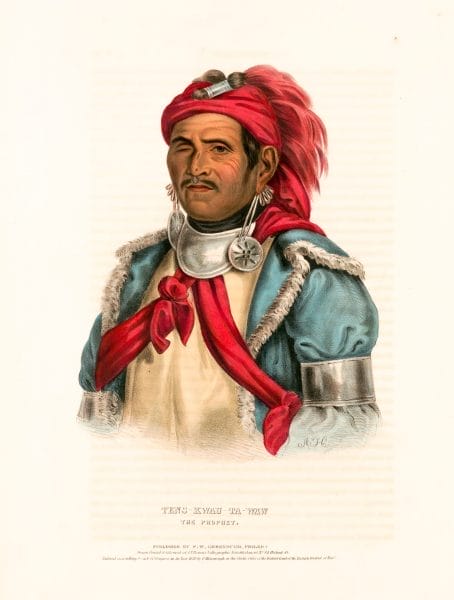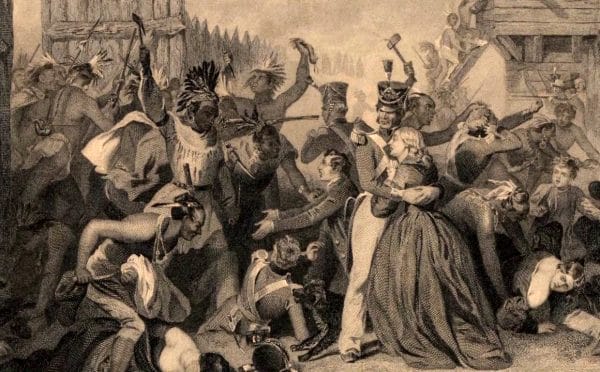Fort Mims Battle and Massacre
 Fort Mims State Historic Site
On August 30, 1813, a force of about 700 Creek Indians destroyed Fort Mims, in present-day Baldwin County, killing 250 defenders and taking at least 100 captives, in the first major battle of the Creek War of 1813-14. Some 400 American settlers, U.S.-allied Creeks, and enslaved African Americans had taken refuge inside a stockade hastily erected on the plantation of Samuel Mims, a wealthy resident of the Tensaw District of the Mississippi Territory. The Creek attack on Fort Mims, and particularly the killing of civilian men, women, and children at the end of the battle, outraged the U.S. public, thus prompting military action against the Creek Nation, which controlled what is now much of modern Alabama.
Fort Mims State Historic Site
On August 30, 1813, a force of about 700 Creek Indians destroyed Fort Mims, in present-day Baldwin County, killing 250 defenders and taking at least 100 captives, in the first major battle of the Creek War of 1813-14. Some 400 American settlers, U.S.-allied Creeks, and enslaved African Americans had taken refuge inside a stockade hastily erected on the plantation of Samuel Mims, a wealthy resident of the Tensaw District of the Mississippi Territory. The Creek attack on Fort Mims, and particularly the killing of civilian men, women, and children at the end of the battle, outraged the U.S. public, thus prompting military action against the Creek Nation, which controlled what is now much of modern Alabama.
 Diagram of Fort Mims
Beginning in the 1780s, southeastern Indians came under increasing pressure by the new U.S. government to cede land for white settlement. American settlers wanted this land for farming, but the Creeks hunted hundreds of thousands of deer on it every year and depended on the deerskins they acquired for most of their income. They used the deerskins to barter for cloth, guns, steel tools, and myriad other manufactured goods. American politicians, anxious to obtain Indian lands for their own increasing constituencies, devised the plan of civilization. This policy called for U.S. federal agents to encourage Indian men to abandon hunting, adopt European-style agriculture, and focus on growing cash crops. U.S. leaders hoped to assimilate Indian peoples to a way of life that would free up their vast hunting lands for American settlement. When implemented, the plan created bitter divisions in Creek society between those willing to adopt new ways and those who wished to retain their traditional culture.
Diagram of Fort Mims
Beginning in the 1780s, southeastern Indians came under increasing pressure by the new U.S. government to cede land for white settlement. American settlers wanted this land for farming, but the Creeks hunted hundreds of thousands of deer on it every year and depended on the deerskins they acquired for most of their income. They used the deerskins to barter for cloth, guns, steel tools, and myriad other manufactured goods. American politicians, anxious to obtain Indian lands for their own increasing constituencies, devised the plan of civilization. This policy called for U.S. federal agents to encourage Indian men to abandon hunting, adopt European-style agriculture, and focus on growing cash crops. U.S. leaders hoped to assimilate Indian peoples to a way of life that would free up their vast hunting lands for American settlement. When implemented, the plan created bitter divisions in Creek society between those willing to adopt new ways and those who wished to retain their traditional culture.
 Tenskwatawa
The Creek men who carried out the massacre were members of the Red Stick faction (named for the red wooden war clubs they carried), followers of Shawnee leaders Tenskwatawa (The Prophet) and his brother Tecumseh, who advocated death to any Indians who allied with the Americans and preached adherence to traditional Indian practices. In mid-1813, as the Creek Nation disintegrated in civil war, the Red Sticks determined to destroy a community of Creeks who had established plantations in the Tensaw District and had taken refuge at Fort Mims. A force of 700 Red Sticks, led by William Weatherford, Far-off Warrior (Hopvyç Tustunuke), and the prophet Paddy Walsh, rushed through the fort’s open gate at noon. Half of the surprised, 100-man garrison of Mississippi Territorial Volunteers died with their commander, Maj. Daniel Beasley, in the first few minutes of battle. Capt. Dixon Bailey, a Creek, and his 45 American and Creek militiamen repelled the Red Stick onslaught and for four hours successfully defended hundreds of civilians huddled inside the flimsy, one-acre stockade. Only when the attackers set the fort’s buildings ablaze with burning arrows did resistance collapse.
Tenskwatawa
The Creek men who carried out the massacre were members of the Red Stick faction (named for the red wooden war clubs they carried), followers of Shawnee leaders Tenskwatawa (The Prophet) and his brother Tecumseh, who advocated death to any Indians who allied with the Americans and preached adherence to traditional Indian practices. In mid-1813, as the Creek Nation disintegrated in civil war, the Red Sticks determined to destroy a community of Creeks who had established plantations in the Tensaw District and had taken refuge at Fort Mims. A force of 700 Red Sticks, led by William Weatherford, Far-off Warrior (Hopvyç Tustunuke), and the prophet Paddy Walsh, rushed through the fort’s open gate at noon. Half of the surprised, 100-man garrison of Mississippi Territorial Volunteers died with their commander, Maj. Daniel Beasley, in the first few minutes of battle. Capt. Dixon Bailey, a Creek, and his 45 American and Creek militiamen repelled the Red Stick onslaught and for four hours successfully defended hundreds of civilians huddled inside the flimsy, one-acre stockade. Only when the attackers set the fort’s buildings ablaze with burning arrows did resistance collapse.
 Massacre at Fort Mims
The Red Sticks’ assault on Fort Mims ranks as one of the great successes of Indian warfare. The massacre of civilians, however, rallied American armies under the cry “Remember Fort Mims.” The ensuing Creek War culminated in a decisive victory for U.S. forces in the Battle of Horseshoe Bend on March 27, 1814, and the Creek Nation’s subsequent cession of over 21 million acres of land to the U.S. in the Treaty of Fort Jackson. Continuing outrage surrounding the massacre contributed to the eventual forced removal of Creeks and other Indians from the Southeast in the 1830s.
Massacre at Fort Mims
The Red Sticks’ assault on Fort Mims ranks as one of the great successes of Indian warfare. The massacre of civilians, however, rallied American armies under the cry “Remember Fort Mims.” The ensuing Creek War culminated in a decisive victory for U.S. forces in the Battle of Horseshoe Bend on March 27, 1814, and the Creek Nation’s subsequent cession of over 21 million acres of land to the U.S. in the Treaty of Fort Jackson. Continuing outrage surrounding the massacre contributed to the eventual forced removal of Creeks and other Indians from the Southeast in the 1830s.
The site of the conflict is commemorated at the Fort Mims State Historic Site, which features a restored blockhouse and well and reconstructed stockade. The park is managed by the Alabama Historical Commission and was listed on the National Register of Historic Places in 1972.
Further Reading
- Halbert, Henry S., and Timothy H. Ball. The Creek War of 1813 and 1814. Edited by Frank L. Owsley Jr. Tuscaloosa: University of Alabama Press, 1995.
- Owsley, Frank L., Jr. Struggle for the Gulf Borderlands: The Creek War and the Battle of New Orleans, 1812-1815. Tuscaloosa: University of Alabama Press, 1981.
- Waselkov, Gregory A. Conquering Spirit: Fort Mims and the Redstick War of 1813-14. Tuscaloosa: University of Alabama Press, 2006.



